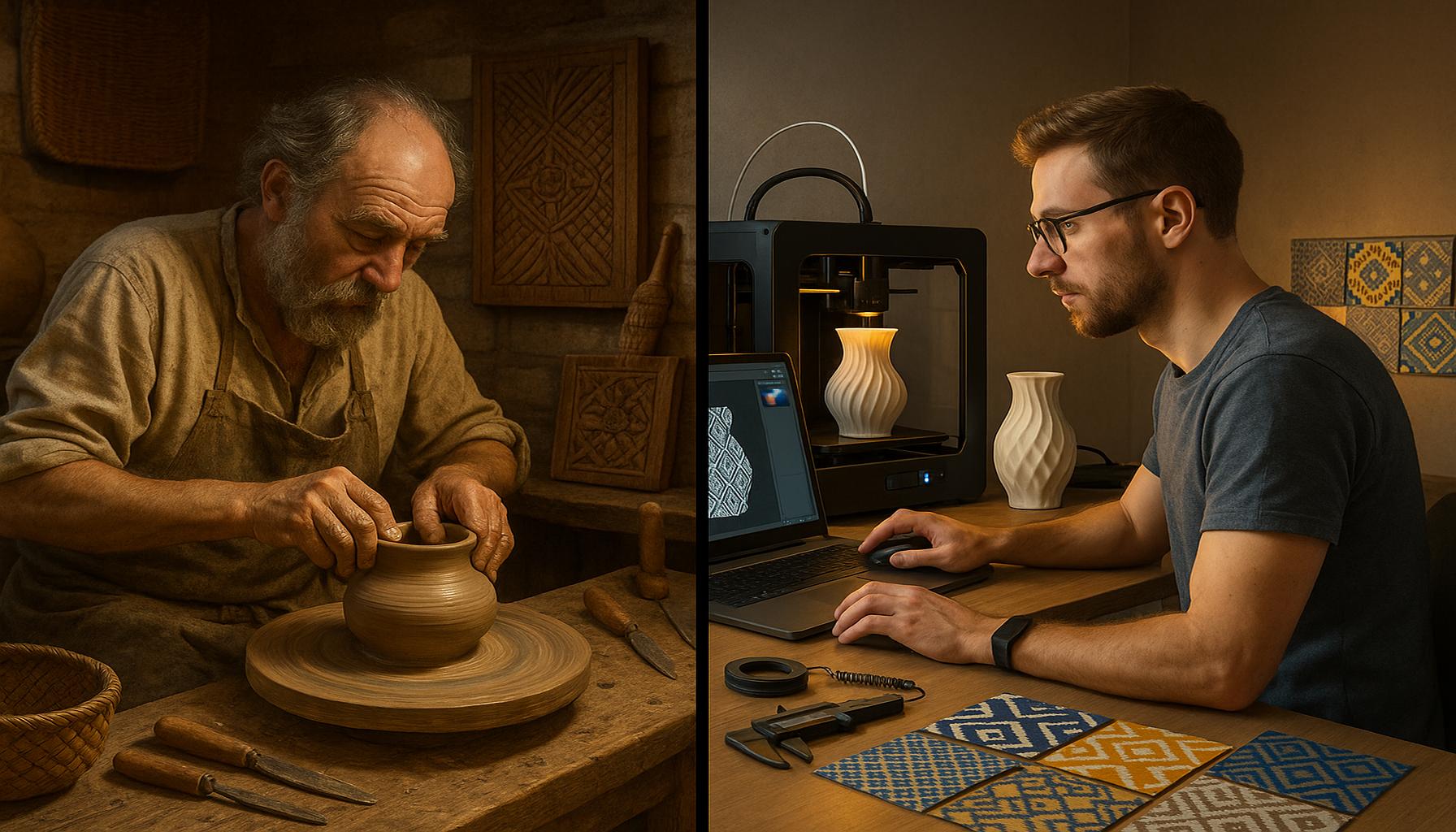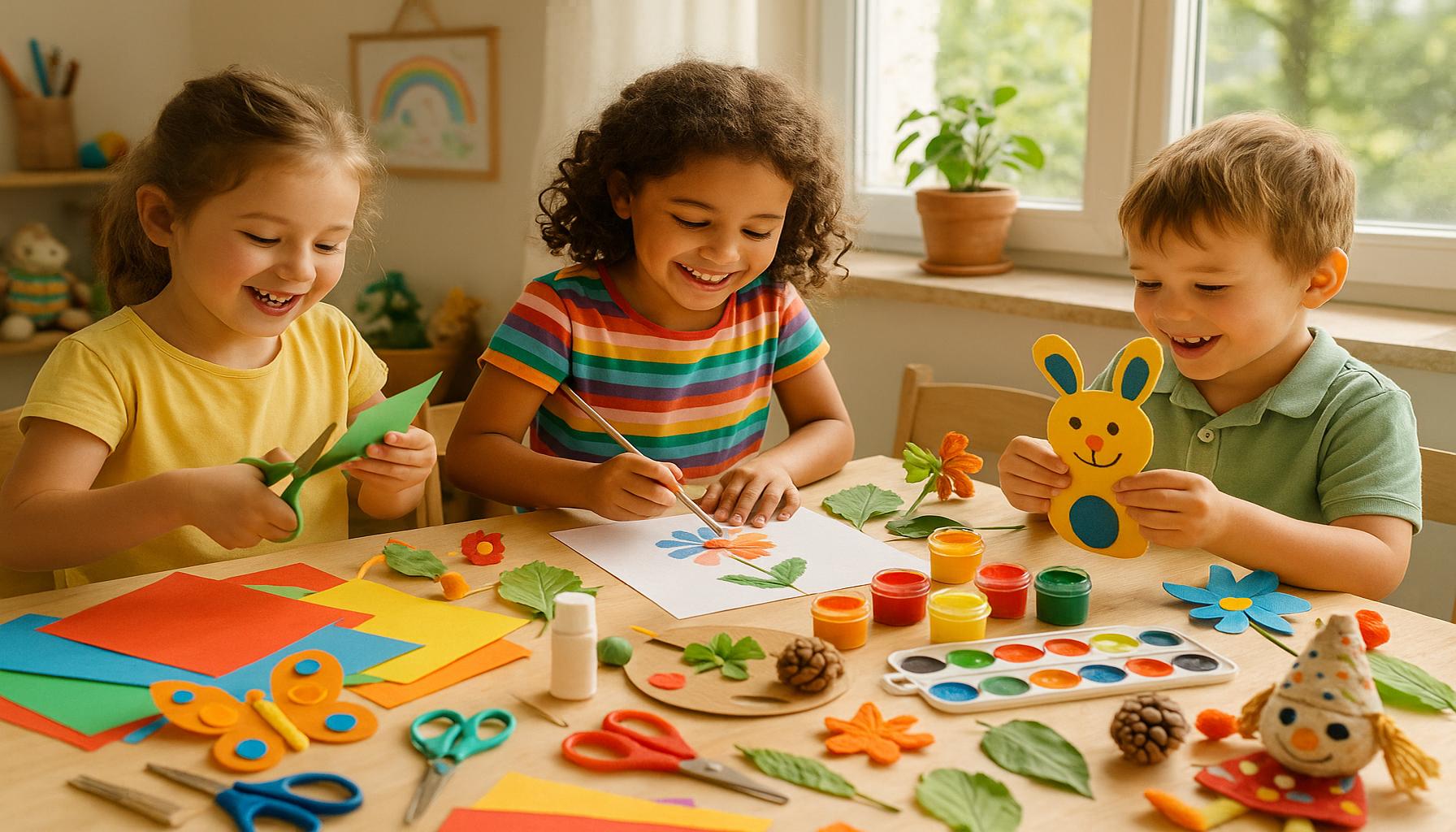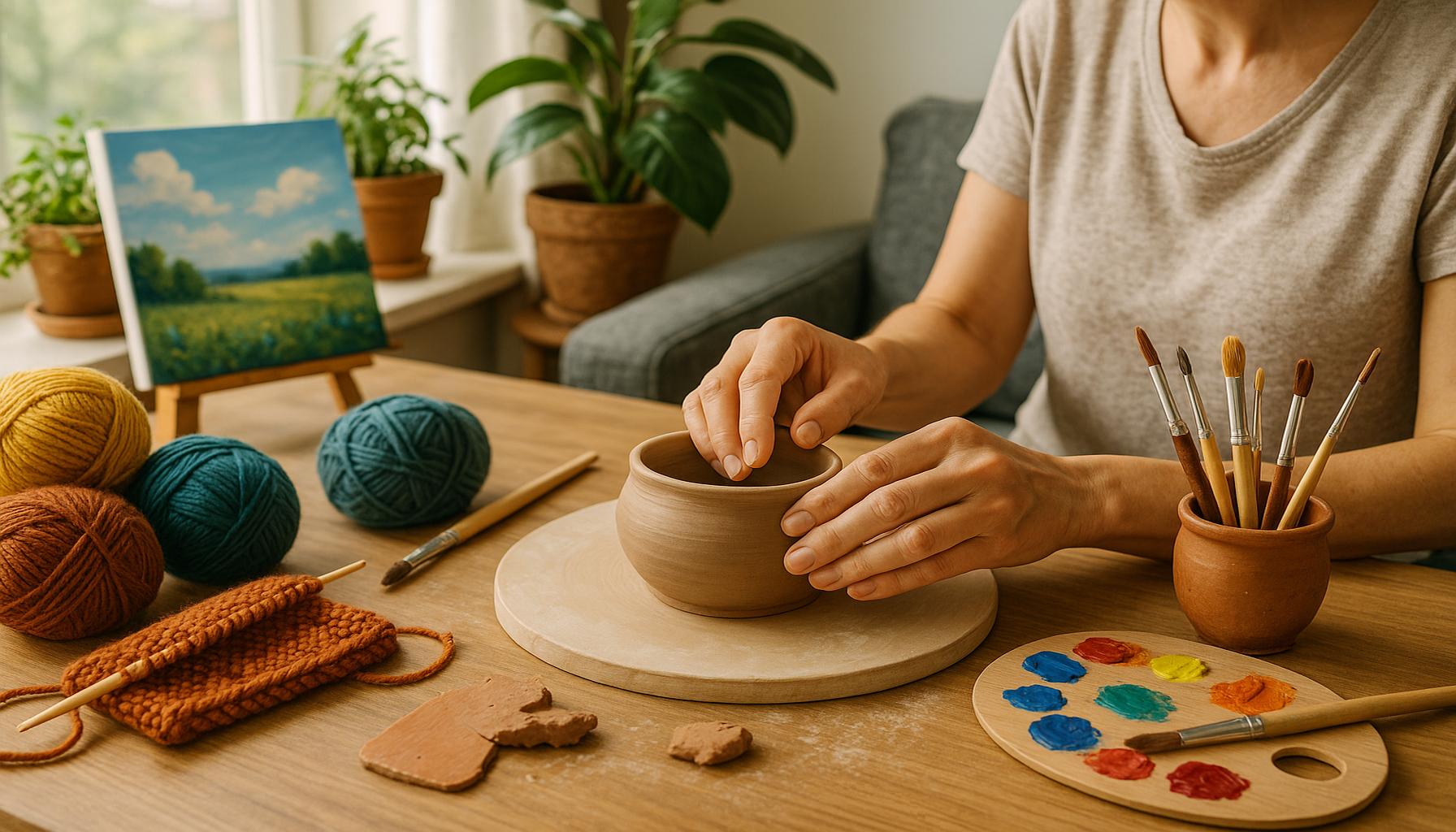The Evolution of Handicrafts: How Manual Traditions Are Adapting to the Digital Age

Transformation of Handicrafts in a Modern World
The landscape of handicrafts is not just a testament to human creativity but also a reflection of cultural heritage and craftsmanship. In recent years, there has been a remarkable shift in how these traditional skills are perceived and valued in the global marketplace. Artisans are no longer confined to local markets; they are now leveraging technology to create, market, and sell their products on a global scale.
Online Marketplaces: Expanding Horizons
Online marketplaces</like Etsy and Amazon Handmade have revolutionized the way craftsmen connect with consumers. In the past, artisans relied heavily on local fairs, craft shows, and consignment in retail shops to showcase their goods. Now, these platforms allow even the smallest cottage industries to reach audiences across the world. For instance, a jewelry maker from a small town in Ohio can easily sell intricately designed pieces to customers in Europe or Australia through these global platforms. This has not only led to increased sales but also a rich exchange of cultural ideas and styles, as artisans are inspired by international trends and tastes.
Social Media Exposure: A New Canvas
With the rise of platforms like Instagram and Pinterest, social media exposure has become an invaluable tool for artisans to showcase their work. These platforms function as visual galleries, allowing craftsmen to share high-quality images and videos of their creations. For example, a textile artist can demonstrate the process of weaving through a time-lapse video, captivating potential customers and building a community around their craft. The ability to interact directly with followers through comments and direct messages creates a personal connection, further enhancing brand loyalty.
Workshops and Tutorials: Knowledge-sharing
Another trend that has emerged is the rise of workshops and tutorials offered online, allowing skilled artisans to share their techniques with enthusiasts. Digital platforms like Skillshare and YouTube have made it possible for artisans to teach everything from pottery to woodworking to a global audience. For example, an artisan specializing in traditional Native American beadwork can reach aspiring bead artists from all walks of life, inspiring a new generation to appreciate and continue these age-old crafts.
Through these innovations, artisans are not just preserving their traditional practices but are also incorporating modern techniques to innovate their offerings. The result is a dynamic environment where craftsmanship thrives alongside technological advancement.

Conclusion: The Future of Handicrafts
The impact of digital technologies on the world of handicrafts cannot be overstated. As consumers increasingly seek unique, handmade items that tell a story, artisans are finding that blending tradition with modernity creates not just economic opportunities but also a sustainable way to keep their crafts alive. The evolving landscape promises exciting new frontiers that not only support the livelihoods of craftspeople but also celebrate the rich tapestry of cultural traditions, ensuring they are passed down to future generations.
DISCOVER MORE: Click here to unlock the benefits of music therapy
Embracing Technology: A New Era for Handicrafts
As the digital age continues to unfold, handicrafts are undergoing a transformative process that redefines not only the way artisans create but also how they reach and engage with their audiences. The traditional concept of craftsmanship, which often evokes images of solitary artisans laboring away in rustic workshops, has expanded to incorporate a multitude of modern tools and platforms that deepen both production quality and market outreach.
Crafting Online Identities
In this age of information overload, artisans are realizing the importance of establishing a strong online identity. Creating a personal brand is essential in capturing the attention of potential buyers and standing out in a crowded digital marketplace. Artisans are now curating online portfolios that reflect their unique style, values, and narratives—further blurring the lines between creator and storyteller. This shift allows them to forge meaningful connections with customers who are increasingly interested in the stories behind the products they purchase.
Moreover, this movement has accelerated the rise of niche markets within the handicraft community. Consumers are looking for authenticity and individuality in their purchases, leading to a burgeoning interest in handmade goods with a personal touch. For instance, eco-conscious consumers are drawn to artisans who source sustainable materials, fostering a sense of community pledging to reduce their carbon footprints.
Innovative Tools and Techniques
The integration of technology doesn’t stop at marketing. Artisans are also incorporating advanced tools into their processes, which allows for enhanced creativity and efficiency. Some examples of how technology is impacting traditional crafting methods include:
- 3D Printing: This revolutionary technology allows artisans to create intricate designs that would be hard to replicate by hand, opening new avenues for creative expression.
- CNC Machines: Computer Numerical Control (CNC) machines enable precise cutting and shaping of materials, ensuring high-quality results with minimal waste.
- Digital Design Software: Programs like Adobe Illustrator and CAD software help artisans visualize and plan their projects, leading to more innovative designs and improved production accuracy.
Additionally, the fusion of traditional methods with modern technology has given rise to hybrid crafts, such as digitally printed textiles that are then hand-embroidered. This blending of techniques not only enhances the artistic value but also attracts diverse demographics who appreciate contemporary aesthetics paired with artisanal skills.
The Role of Community and Collaboration
Community is crucial in this evolution of handicrafts, as artisans increasingly engage in collaborative projects that span across various disciplines. These partnerships can help leverage individual strengths, share resources, and amplify reach. For instance, a local potter might collaborate with a ceramic artist and a graphic designer to create a line of products that merge clay art with striking visual elements. This collaborative spirit reflects a broader trend where shared knowledge and techniques are encouraged, leading to innovation that serves a collective vision.
As these traditional crafts evolve within a digital context, they undergo a renaissance that honors the past while embracing the future. Handicrafts are no longer static; they are a vibrant expression of culture, innovation, and sustainability, continuously adapting to reflect the values of their makers and consumers alike.
As we delve deeper into the evolution of handicrafts, it becomes evident that the intersection of manual traditions and digital technology is creating a rich tapestry of innovation. Artisans are now leveraging online platforms to showcase their work, reach global markets, and connect with customers in ways that were unimaginable a few decades ago. This transformation is not only broadening the reach of traditional crafts but also fostering a vibrant community of makers who share techniques and ideas across continents.Online marketplaces like Etsy and social media channels such as Instagram have become pivotal for craftspeople. They not only offer a platform for selling handmade goods but also serve as spaces for storytelling and brand-building. With a few clicks, artisans can showcase their unique creations, tap into niche markets, and cater to consumers who are increasingly interested in the origin and craftsmanship of the products they purchase. The digital age has turned what was once a localized trade into a global phenomenon, allowing manual traditions to flourish in unprecedented ways.Adapting to these new tools is essential for surviving and thriving in the modern craft landscape. Many artisans are now integrating advanced technologies like 3D printing and laser cutting into their workflows, enabling them to experiment with new designs and materials. This fusion of traditional techniques with cutting-edge technology is a testament to the resilience of handicrafts, proving that they can withstand the test of time while embracing progress.Moreover, the rise of e-learning platforms has enabled artisans to share their knowledge and skills with a broader audience. Workshops and tutorials available online provide individuals with opportunities to learn traditional techniques from the comfort of their homes, ensuring that the labor of love inherent in handicraft continues to be passed down through generations. This dynamic exchange of knowledge is enhancing the accessibility of artisanal skills, thus preserving cultural heritage.As we navigate through this exciting evolution, the key lies in striking a balance between tradition and innovation. Brands that manage to blend their artisanal roots with modern practices are not only preserving their heritage but also ensuring their relevance in the contemporary market. The future of handicrafts is undoubtedly bright, fueled by creativity, adaptability, and an unwavering commitment to the artistry of manual traditions. For those looking to explore this fascinating fusion of old and new, the digital age presents endless possibilities, inviting consumers and craftspeople alike to participate actively in this ongoing narrative.
DIVE DEEPER: Click here to uncover the art of storytelling
Building Global Marketplaces: The Expansion of Handicraft Sales
As traditional handicrafts evolve, the digital age has revolutionized the ways in which artisans sell their work. Global marketplaces like Etsy, Amazon Handmade, and local platforms such as ArtFire have created expansive arenas for artisans to reach a broad audience beyond their immediate communities. By leveraging the power of the internet, artisans are no longer confined to local fairs or craft shows; instead, they can showcase their work to interested buyers from across the globe.
Personalized Shopping Experiences
These digital platforms often offer features that allow artisans to curate personalized shopping experiences for consumers. Many sellers utilize strategies such as live demonstrations or customer engagement through social media to provide insights into their crafting process. For instance, artisans may host live Instagram sessions where they demonstrate intricate techniques, allowing consumers to witness the dedication and skill that go into each piece. This level of interaction fosters a deeper appreciation for craftsmanship and strengthens the bond between creator and customer.
Additionally, the rise of immersive technology is reshaping the shopping experience. Virtual reality (VR) and augmented reality (AR) innovations enable shoppers to visualize how handicrafts will look in their own homes. Brands are using these technologies to create interactive elements, such as AR apps that allow consumers to see how a handmade piece fits into their living space. This kind of engagement brings an added layer of personalization to the shopping experience, catering to the evolving preferences of modern consumers who seek more than just a product—they want a story.
Sustainability and Ethical Consumption
As global consciousness shifts towards sustainability, many artisans are adapting their practices to align with the values of environmentally-aware consumers. Artisans are increasingly using recycled or locally-sourced materials, and some are transparent with their production processes, labeling items that adhere to eco-friendly standards. This commitment enhances the attractiveness of their creations, tapping into the growing trend of ethical consumption.
Furthermore, platforms like Patagonia and Warby Parker are pushing for ‘buy one, give one’ models, where for every purchase made, a donation is made to a social cause. Artisans embracing similar initiatives can boost their appeal and brand loyalty while contributing to impactful causes—a win-win scenario for both creators and consumers.
Community Support and Education
As a result of this digital transformation, community support has blossomed. Social media platforms play a crucial role in fostering connections among artisans, encouraging skill-sharing and collaboration. Online workshops and courses are becoming increasingly popular, helping artisans to develop their crafts as well as their business acumen. For example, initiatives like Skillshare and local community colleges offer courses ranging from woodworking to digital marketing for artists, empowering them with the knowledge needed to thrive in an evolving marketplace.
This educational focus not only enhances individual craftsmanship but also strengthens the handicraft industry as a whole. By creating networks that promote shared learning, artisans are better equipped to innovate while preserving traditional techniques. As artisans continue to adapt their skills and approach to fit the digital landscape, they remain anchored in the rich culture and historic values that define the essence of handicrafts.
EXPLORE MORE: Click here to discover your artistic side
Conclusion: Bridging Tradition and Technology
The journey of handicrafts in the digital age exemplifies a remarkable adaptation that honors time-honored traditions while embracing the limitless possibilities of modern technology. As artisans navigate this evolving landscape, they leverage platforms like Etsy and Amazon Handmade to transcend geographical boundaries and connect with diverse audiences. This transformation not only amplifies sales potential but also fosters a deeper connection between maker and consumer through personalized shopping experiences.
Furthermore, the integration of sustainability into the handicraft industry reflects a growing cultural awareness. Consumers increasingly value ethical consumption, prompting artisans to innovate with eco-friendly materials and transparent production processes. The rise of community support and education via online workshops contributes to the preservation of traditional techniques while empowering artisans with the necessary skills to thrive in a competitive marketplace.
As we look to the future, it’s clear that handicrafts will continue to evolve, riding the wave of digital advancements while remaining firmly grounded in their rich cultural heritage. This synthesis of the past and present offers new opportunities for creativity and collaboration among artisans, ultimately ensuring that their crafts resonate within the hearts of consumers worldwide. The story of handicrafts in the digital age is not just about survival; it represents a vibrant tapestry woven from tradition, innovation, and community—a narrative worth exploring and celebrating.


